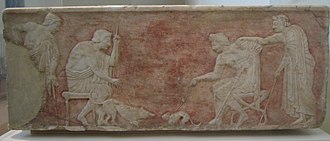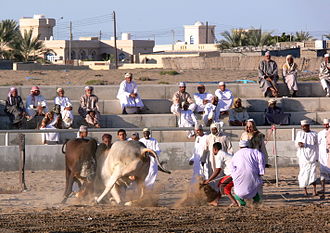Animal fight


In animal fights , two or more animals compete against each other, although they do not necessarily have to belong to the same breed or species . These events were already held in antiquity in so-called agitation theaters, whereby such a theater could be a coliseum , an amphitheater or a built pit, and were used for popular amusement.
Today bets are made on illegal animal fights . But there are also legal animal fights, for example in some provinces of China.
history
Animal fights have always had a great show value. The aggressiveness associated with the territorial behavior of the male animals was used. Even in ancient times, Babylonian, Assyrian or Egyptian rulers organized animal fights and large animal hunts for display purposes. In the Roman circus games "beasts" (lta. Bestia - raging animal) were used for entertainment. So let Sulla 100 lions fighting each other, Pompey 600 and Caesar 400, even he had a rhinoceros against elephants rushing.
Animal fighting found its peak in popularity in antiquity with animal baiting in the Roman Empire , the effects of which can be seen in bullfighting to this day.
Even today, animal fighting has a large following in many parts of the world. You let chickens (certain types of birds), roosters or dogs loose on each other and train them to fight.
Later, special breeds of fighting animals were bred .
Animal baiting
The so-called rushing represent a special form of animal fighting. These were to be found in a wide variety of cultures and were very widespread until the beginning of the 20th century. The baiting consisted in the trained dogs being let loose on another animal with the aim of biting it to death. Bets were made, usually either on individual dogs or on the length of time that the chased animal survived. The target animal was usually made relatively defenseless beforehand by tying it down or removing its teeth. Animals as diverse as badgers, donkeys, ducks or even bears and lions were used to hunt animals.
Gerhard Roth describes in his book A Journey into the Inner City of Vienna (Archive of Silence, Volume 7) a hate theater in Vienna , which offered space for 3000 spectators. This is shown on an engraving from 1790. In 1796 it was destroyed by fire. Afterwards, Emperor Franz II no longer issued a permit to conduct animal hunting. The Hetzgasse in the third district of Vienna is still a reminder of this hate theater.
During the baroque period there were also facilities in other cities in Germany that were used to hold animal fights for the entertainment of a courtly audience. a. in Berlin ( Hetzgarten ), Königsberg and Nuremberg ( Fechthaus ).
Increasing ban on animal fights
Since the end of the 18th century, animal fighting was increasingly banned. Sensational animal shows were now offered by the traveling menageries.
Educational pamphlets in relation to animal fighting
- 1789 Introduction to the Principles of Morals and Legislation by Jeremy Bentham
- 1755 Animals Have a Right to Avoid Unnecessary Pain by Francis Hutcheson
- 1776 Pain is pain, whether inflicted on humans or animals by Humphry Primatt
- 1790 the fate of animals must be eased by Lauritz Smith
Animal fight in the twilight
In the present, animal rights organizations sometimes oppose any use of animals by humans, while other groups take action against certain companies and not others. In the West in particular, many people reject the use of animals for martial arts and even the term sport in this context, but support (also as active people) fishing or hunting , with hunting with dogs in Germany today in accordance with Section 3 (8) Animal Welfare Act are prohibited. Certain animal martial arts are prohibited by law in Western Europe.
Prohibitions
In most western countries, animal fighting is a criminal offense or at least prohibited.
-
Germany ; punishable under the Animal Welfare Act
- Saxony ; banned since 1830
- Württemberg ; banned since 1839
- Hanover ; banned since 1847
- United Kingdom ; banned since 1835
- Switzerland ; banned since 1842
- United States ; banned since 1829
- Norway ; banned since 1842
- Sweden ; banned since 1857
- Denmark ; banned since 1857
List of animal martial arts
Similar, usually outdated, practices
Similar animal cruelty practices that are either no longer or no longer practiced with live animals:
Supporting associations
- Countryside Alliance (Great Britain)
literature
- Gerhard Roth: The Archives of Silence, Volume 7, Pages 7-13 "The kk privileged Hetztheater" . Fischer Taschenbuch Verlag, Frankfurt am Main 1993, ISBN 3-596-11407-1 .
Individual evidence
- ↑ http://www.bz-berlin.de/panorama/china-blutiger-hundekampf-fuer-ein-paar-zigaretten
- ↑ Lexicon of Antiquity, Art. Beasts
- ^ Image archive of the Austrian National Library
- ^ Report in the Wiener Zeitung of September 3, 1796
